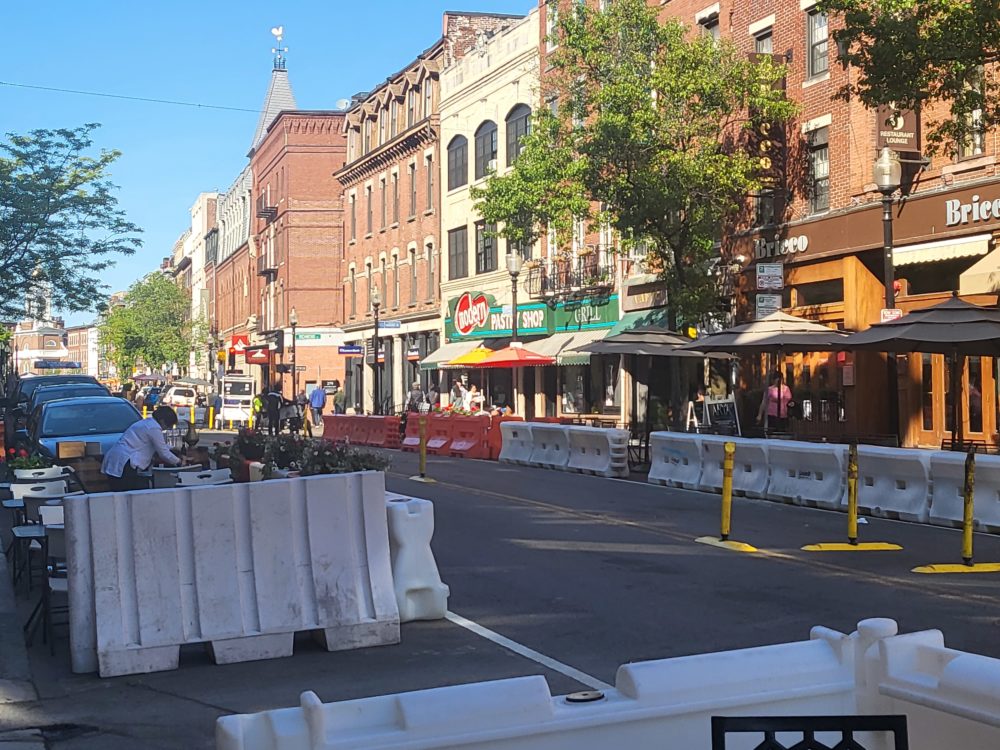Outdoor Dining Should Stay
And why free parking should go
If there was one silver lining to the pandemic, it was spurring the broad (albeit temporary) legalization of outdoor dining in U.S. cities.
This has long been logistically difficult for restaurants in dense urban settings, because adjacent space is used for on-street curb parking, often free or underpriced. The legalization, which was spurred by the need for safe open-air dining, proved popular and helped many restaurants stay afloat. Even as urbanists have advocated for the policy to become permanent, cities are now rolling it back.
We think this is a mistake: instead of reverting to the status quo ante, where the car was king and establishing outdoor dinner seating was cumbersome, city governments should use this opportunity to let users bid for curb space on a level playing field.
In Boston, for instance, city officials and restaurant owners in the North End neighborhood have been embroiled in a battle over an outdoor dining policy change. Mayor Michelle Wu planned to introduce a $7,500 annual fee for restaurants in the neighborhood (but not citywide) that wish to lease curb space for seating. Restaurant owners have responded by calling the fee capricious. Moreover, there is no corresponding move to increase the charge for parking in the area—in fact, resident parking is free in Boston.
The mayor’s instinct that curb space has value is not wrong; the basic problem is that a charge is being applied only to outdoor dining, and only in one neighborhood. As we’ve argued before, making curb space available for free or below market value leads to a tragedy of the commons dilemma, as private vehicle owners “overuse” the space, sometimes even storing their cars indefinitely.

(Credit: Ethan Finlan.)
This overuse helps keep cities car-dominant. The North End is a good example—it’s a dense, walkable historic neighborhood with narrow streets, and ought to be conducive to year-round sidewalk dining and other activities. But prior to the emergency outdoor dining ordinance, the main thoroughfares were crowded with car traffic during peak activity times, and cars consumed the space in front of restaurants. Even when some outdoor dining is allowed, parked cars and high traffic make the experience unpleasant, and as outdoor dining has increased in other cities, there have been dangerous collisions, for instance in New York City and Washington, DC.

There’s a clear economic cost to this pro–free-parking regime, too. According to Marco Conner DiAqui, a New York City-based alternative transport activist, “seventy-five percent of our public curb space is devoted to the movement and storage of vehicles. New York City has three million free parking spaces … When just 0.2 percent of these spaces were put to higher use for outdoor dining during the COVID pandemic, New York City saved 100,000 jobs.” That’s to say nothing of the general economic benefits of allowing other entrepreneurial activity along these curbs, such as food carts or storage facilities for micro-mobility firms.
Here’s the market-based alternative we propose: have city DOTs lease individual curb spots to the highest bidder. In commercial districts, this would likely be restaurants, who would pay more for the opportunity to seat dozens more patrons than would a solo driver trying to park. This would also solve some quality-of-life issues, since restaurants that pay for the right to use outdoor space would have an incentive to make it pleasant and clean in order to attract patrons.
Many cities besides just Boston and New York are weighing the outdoor dining issue, so hopefully there will be experimentation. Alexandria, VA, has begun charging businesses $3,000 to use curbside parklets in the city’s Old Town neighborhood. The city already charges for parking there, so the $3,000 is seen as a replacement cost, although mayor Justin Wilson specified that “what I do not want to do is charge a penny more than what makes these [parklets] happen, because ultimately we want them to happen.”
In the true market bidding process we envision, however, a city, rather than leasing based on particular uses that it wants to either promote or penalize, grants the space to the highest bidder. Charges would not just apply to certain neighborhoods, although the demand-based pricing may fluctuate by area and time-of-day.
This would reveal—as the rise of outdoor dining already has—just how vastly of an untapped resource curb space is in virtually all U.S. cities. Having a market-based pricing system for legalizing it would help further drive outdoor dining’s popularity while reversing the favoritism cities show towards the automobile.
This article was co-authored by Market Urbanism Report content staffer Ethan Finlan.
Catalyst articles by Scott Beyer | Full Biography and Publications
